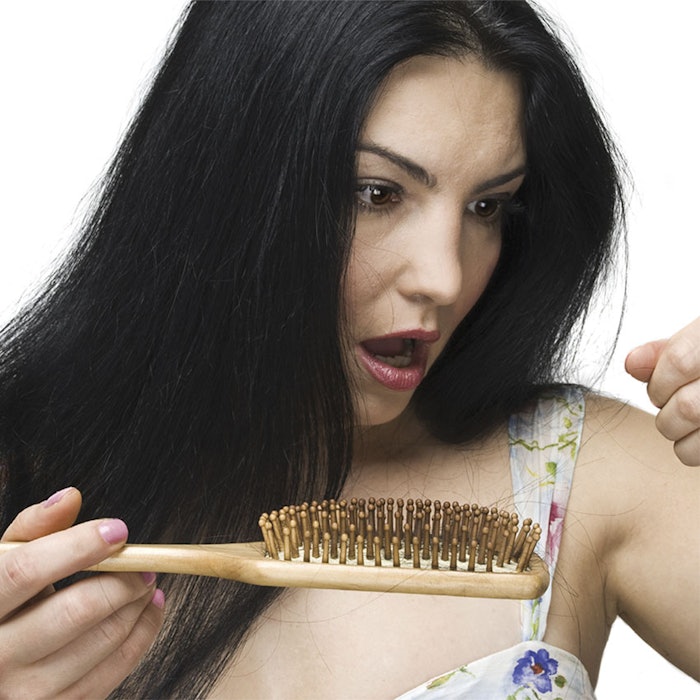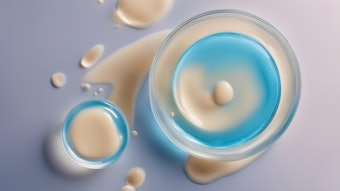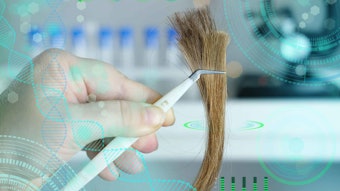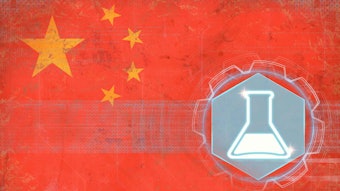
The term hair damage is tossed around our industry ubiquitously and haphazardly. It represents a decidedly generic term insinuating that hair properties have been negatively altered in some way, shape or form relative to the initial, freshly grown state. Yet, the causes and materialization of these changes are plentiful. A small sampling of irksome symptoms might include undesirable tactile properties, visual dullness, an increased propensity for breakage and/or an unruly and unmanageable disposition. Possible instigators, on the other hand, might involve grooming-related abrasion and fatiguing, extreme temperatures, environmental battering, chemical treatments and others.
Log in to view the full article
The term hair damage is tossed around our industry ubiquitously and haphazardly. It represents a decidedly generic term insinuating that hair properties have been negatively altered in some way, shape or form relative to the initial, freshly grown state. Yet, the causes and materialization of these changes are plentiful. A small sampling of irksome symptoms might include undesirable tactile properties, visual dullness, an increased propensity for breakage and/or an unruly and unmanageable disposition. Possible instigators, on the other hand, might involve grooming-related abrasion and fatiguing, extreme temperatures, environmental battering, chemical treatments and others.
There is frequently a desire to measure the degree to which hair has become damaged, often for the purpose of evaluating the aggressiveness of known deleterious treatments or to try and quantify an ability to protect and possibly even "repair" the hair. But the above discourse shows how this is not a trivial task. Hair damage is a convoluted and multifaceted concept; a fact that is perhaps lost and therefore not properly accepted and appreciated by the industry's use of such an imprecise, broad and humdrum descriptor.
Our industry needs a more precise means for describing the vast number of ways by which the hair structure can be altered or compromised. Clearly, the consumer word damage will not go away but only by adequately describing the problem can better solutions be conceived. The final article in this trilogy1, 2 on hair damage further explores how this might be accomplished. (see Part I and Part II)
The Scope of the Problem
To illustrate the problem, consider what happens to hair upon exposure to a simple, skeletal hydrogen peroxide bleaching treatment:
- Penetration of the solution between cuticle scales will weaken the inter-cuticular cement and leave this protective structure more susceptible to deterioration.
- Oxidative conditions, in combination with elevated pH, will irreversibly increase the swelling capacity of fibers and place additional strain on the cuticle structure each time the hair is wetted.
- Degradation and dissolving of melanin pigment granules leads to lightening of the hair color, while seemingly leaving behind microscopic voids.
- Oxidative side reactions with hair protein deplete strength-supporting cystine disulfide bonds by conversion to cysteic acid.
- Individual hair fibers become weaker and more prone to breakage.
- The dry state modulus increases, leaving individual fibers stiffer.
- The lipid layer on the very outside surface of a hair fiber—the f-layer—is removed, changing its interaction with water and possibly leading to slower hair drying.
- Enhanced swelling in combination with a more hydrophilic character can lead to increased fiber water content.
- Lipid structure becomes weakened and components are more easily removed.
This quickly becomes a lengthy list—and it is by no means exhaustive. On top of this, daily activities and maintenance routines add extra repetitive—and often exacerbated—stimuli for further structural wear and tear.
To this end, now consider what happens to hair during simple washing:
- Fibers swell, putting strain on the cuticle.
- Swollen fibers are then subjected to inter-fiber abrasion and friction, while likely causing cuticle wear.
- Bending and twisting of fibers could initiate localized cuticle uplift.
- Fibers encounter various tugging and fatiguing forces while in a decidedly weaker, plasticized state.
- Lipids and degraded protein may be leached from the hair.
Grooming, heat styling and all other hair care habits and practices, in a similar vein, lead to their own lengthy lists.
These thought exercises are useful in identifying elements at the heart of technical issues but at the same time they produce a rather daunting number of factors to potentially consider. A means of further categorization might be based on their materialization into commonly heard consumer concerns and issues such as: sensorial-compromised hair, strength-compromised hair and manageability-compromised hair.
Heat, high pH relaxers and formaldehyde-based Brazilian keratin treatments all compromise hair’s tensile properties without notable cysteic acid formation.
Sensorial-compromised Hair
Sensorial-compromised hair likely starts with cuticle breakdown where uplifted, irregular and eroded cuticle “tiles” impart a rough feel while also producing a dulled appearance (see Figure 1). This state likely occurs primarily due to mechanical manipulation.
During grooming, fibers slide past each other in a highly chaotic manner, generating considerable frictional and abrasive forces that wear on the cuticle structure. Diminishing surface properties generate still higher friction and a self-perpetuating cycle is set up (see Figure 2) with correspondingly mounting sensorial negatives. Chemical treatments seemingly exacerbate this process via weakening of the cuticular intercellular cement.
Another potential contributor to sensorial negatives could be increased fiber stiffness, which seemingly arise due to all manners of insults. The previous article in this series2 showed how bleaching raises the dry state modulus of hair (i.e., fiber stiffness) but further testing demonstrates how this state can also transpire after other chemical treatments (i.e., perms, formaldehyde-based Brazilian keratin treatments, etc.). Similarly, Figure 3 shows the same occurrence in heat straightened hair, while an especially pronounced effect seemingly arises as a consequence of UV exposure.
The mechanism for this unexpected alteration of hair’s mechanical properties is still unclear, but this notable change—in concert with declining surface properties—would seem to be behind consumer language such as rough, coarse, dry, straw-like, lacking in smoothness or softness, etc.
Strength-compromised Hair
To the consumer, the primary symptom of strength-compromised hair is likely a heightened degree of hair breakage during everyday habits and practices. As has been shown,2 conventional mechanical testing experiments reveal how the underlying tensile properties of single fibers can be diminished by a variety of insults, which act to alter the chemistry and structure of proteins within the internal cortical structure of the hair.
As an aside, here there may also be desire to specify the nature of these transformations. For example, perms, bleaches, permanent color treatments and UV exposure all involve an oxidative stimulus whereby cystine concentration is depleted with commensurate formation of cysteic acid. This new species can be identified relatively easily in hair by spectroscopic measurement, and acts a marker for oxidative modification of the protein. Accordingly, it becomes evident that heat, high pH relaxers and formaldehyde-based Brazilian keratin treatments all compromise hair’s tensile properties without notable cysteic acid formation. In short, different reagents transform the protein chemistry and structure in different ways.
In the laboratory, we tend to study the influence of these various insults on hair individually, but consumers frequently mix and match such practices while also periodically reapplying treatments to recreate desired looks and touch-up new growth. It is surprising to learn just how weak hair can become when harvested from the heads of some individuals.
Instinctively, diminished mechanical strength—irrespective of the stimulus—would seemingly make hair more prone to breakage but as this column will cover, mitigating factors exist.
Previously unrecognized factors can have a sizable—and possibly dominant—impact on the rate at which hair fibers break during everyday grooming.
Manageability-compromised Hair
Manageability-compromised hair might begin with an issue as simple as difficulty in brushing or combing, yet factors already described can also be conceptualized as contributors. Increased fiber stiffness might add to an unruly disposition where hair is more difficult to style. The combination of increased stiffness and higher inter-fiber friction suggests hair would not move in a fluid, flowing manner.
Broken fibers will protrude at different lengths from others and produce undesirable frizzies. Often these fragmented tips will fray into unsightly split ends. The ability to create sleek, aligned styles is hindered and might manifest as a general perception of frizz.3
Forward-looking Strategies
With problems identified, forward-looking strategies become apparent. Improved hair health and appearance might be obtained by:
- Repair/reversal of induced changes,
- Removal of negative symptoms, and/or
- Reducing the occurrence of negative effects.
Repair/reversal: The repair of anything generally constitutes a sizable undertaking, so perhaps it is again worth noting the magnitude of the problems at hand. In a nutshell, cuticle “tiles” become battered, eroded and torn free from their underlying cement, while chemical reactions have altered the fundamental protein composition and structure. Solutions to these issues are not readily apparent.
Manageability-compromised hair might begin with an issue as simple as difficulty in brushing or combing.
One possible exception to this line of thinking might involve hair’s lipid structure. The function and importance of these components is also not well-understood. Hair’s structure is generally considered to consist of around 90% protein and only 10% lipid. Not surprisingly then, the majority of scientific papers in the literature on this topic focus on the protein.
Lipid components are widely believed to be leached from the hair during everyday wash and care practices but the evidence is not overwhelming. If true, maybe replenishment of these materials could be possible wherein similar materials could diffuse back into the hair. It is not known what symptoms are caused—and therefore could possibly be reversed—by this process, but on paper at least, this seems more feasible than repair of protein structures.
Removing negative symptoms: True fiber repair would seem to necessitate feats of micro-engineering but in the eyes of consumers at least, a comparable end result can be obtained by elimination of offending symptoms. The alleviation of sensorial negatives, the cessation of worrisome breakage levels and/or the mitigation of manageability issues will all return an individual’s hair properties to a desired state.
Our industry relies on conventional conditioner products to achieve many of these goals. The deposition of a highly lubricious and esthetically-pleasing surface coating can effectively mask many consequences of degrading cuticle structure. To illustrate, Figure 4 shows instrumental wet combing results for different hair types in both an untreated and conditioned state.
Combing forces rise dramatically for unconditioned hair as a consequence of chemical treatments with increasing severity. Yet, in each instance, washing with a leading commercial conditioner returns these forces to a level commensurate with conditioned virgin hair. In short, while the hair structure still undergoes all of the issues described earlier, the consumer does not encounter problems.
Surface lubrication also produces a sizable benefit in terms of reducing hair breakage. To illustrate, Figure 5 shows results from a standard repeated grooming experiment4 where hair tresses were brushed 2,000 times with subsequent counting of broken fibers. Conventional tensile experiments demonstrate no changes in the fundamental mechanics of conditioner-treated hair, but the benefits in terms of anti-breakage are undeniable.
Evolving theory is showing how previously unrecognized factors can have a sizable—and possibly dominant—impact on the rate at which hair fibers will break during everyday grooming.5 High on this list is the magnitude of the fatiguing (brushing) forces. As shown, surface lubrication greatly lowers these forces and the tendency for breakage is hugely curtailed. The consumer again encounters a reprieve.
Reducing the occurrence: An old adage suggests “an ounce of prevention is equal to a pound of cure.” Yet, long term abstention from coloring, heat styling or other well-entrenched yet deleterious habits and practices cannot realistically be expected. Quite simply, the benefits outweigh the negatives.
Again, surface lubrication comes to the rescue. The ability to reduce friction and abrasion provides a means of interrupting the self-perpetuating cycle to surface damage shown in Figure 2. Similarly, lower fatiguing forces greatly limit fiber breakage and help protect against split end formation.
The alleviation of sensory negatives, the cessation of breakage levels and/or the mitigation of manageability issues will return hair to a desired state.
Summary
The goal of this trilogy of articles has been to highlight the complexity by which hair’s structure can be modified by everyday habits and practices. To most, this is simply damage, but use of this vague and lackluster descriptor sidesteps any technical comprehension.
In this specific article, outside of the introductory section, I have purposely avoided using this generic term. Unquestionably, this exercise represented somewhat of an ordeal and ably demonstrated the casual nature with which it is tossed around. But in doing so, I found myself searching for alternate words and phrases, which inevitably involved deeper contemplation of underlying processes. We are reminded that protein chemistry can change, structural building blocks can be altered and in some cases degraded, and certain components might progressively be leached away.
Lists of possible occurrences quickly become sizable and there is perhaps a desire to subdivide or categorize a dauntingly large problem. The first two articles in this series attempted to provide some specificity by focusing on the regions of the hair where changes predominantly manifest, i.e., surface or bulk. Another reasonable strategy might involve classification based on the nature of the insult. Here, it is now suggested that combining both of these ideas might represent the most useful approach.
The expression grooming-related surface abrasion provides a detailed description of cause and manifestation. To the hair scientist, this implies a degree of cuticle wear—chipping, cracking, uplifting—but likely with minimal impact on the cortex. This provides a distinction from heat styling-related surface abrasion, which possibly provides a different manifestation of surface attrition, but also with a degree of internal structure alteration.
Similarly, bleaching related cortex modification denotes oxidative chemical modification of the hair protein, which will be accompanied by now well-known changes in fiber properties (i.e., lower cystine levels, increased cysteic acid levels, diminished wet state tensile properties, enhanced dry-state stiffness, etc.). The specificity of this description again distinguishes from different chemistries associated with, for example, heat styling related cortex modification or relaxer-related cortex modification.
Taking this one step further, consumer-perceived issues could also be incorporated. For example: strength compromised hair as a result of bleaching related cortex modification; or sensorial compromised hair as a result of surface damage caused by grooming wear and tear.
While undoubtedly a bit of a mouthful, these expressions clearly define the issues at hand in terms of the symptom, the manifestation and the cause and, in doing so, allow for strategies to be conceived for repairing, masking or limiting each problem. For instance, returning to a previous example, a solid strategy for truly repairing strength-compromised hair as a result of bleaching related cortex modification might be to introduce new cross-linking bonds. The tactic is a sound one but it represents a formidable task. Therefore, an alternative proposition, as described earlier, might be to use surface lubrication to mask the symptom.
These strategies, in turn, point to the types of molecules that could—and possibly equally as important, could not—produce the desired outcome. New bonding necessitates reactive chemistry together with all its accompanying worries. Conventional cosmetic ingredients—surfactants, oils, polymers—have no such reactivity. They can however be formulated in ways to produce the surface lubrication that effectively masks and mitigates so many issues.
References
- TA Evans, How Damaged is Hair? Part I: Surface Damage, Cosm & Toil 132(4) 38-48 (Apr 2017)
- TA Evans, How Damaged is Hair? Part II: Internal Damage, Cosm & Toil 132(6) 36-45 (Jun 2017)
- TA Evans, Defining and Controlling Frizz, Cosm & Toil 130(4) 46-53 (2015)
- TA Evans, Measuring Hair Strength, Part II: Fiber Breakage, Cosm & Toil 128(12) 854-859 (Dec 2013)
- TA Evans, A unifying theory for visualizing the causes of hair breakage and subsequent strategies for mitigation, J Cos Sci 68 137-140 (2017)










